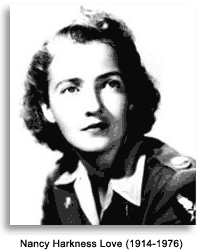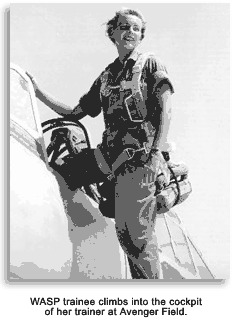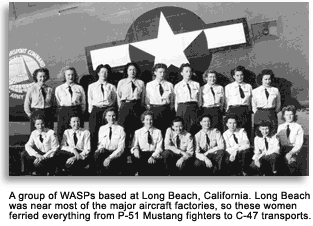Women in aviation were virtually unheard of in the early 1900s. Women’s primary role at that time was to take care of their families. Few considered leaving their traditional roles to take on new ones; less than 25 percent of American women worked outside the home. It required supreme sacrifice to rise above the common expectations of others, and reach to fulfill their dreams — some of which included flying.
In the midst of the world’s greatest depression, the world’s greatest war began and things changed dramatically. Suddenly there was a need for female workers in all aspects of society. Few hesitated to answer the call, wherever that might lead. Several brave women stepped forward to fly airplanes. Much to their dismay, it was not an easy venture.
 Flying was a province reserved solely for men, who believed that women were not emotionally stable enough to pilot airplanes. They were proved wrong. When America entered World War II with the Japanese bombing of Pearl Harbor, the need became great for everyone to support the war effort. The nation's sudden engagement in the war meant more opportunities for women
Flying was a province reserved solely for men, who believed that women were not emotionally stable enough to pilot airplanes. They were proved wrong. When America entered World War II with the Japanese bombing of Pearl Harbor, the need became great for everyone to support the war effort. The nation's sudden engagement in the war meant more opportunities for women
In 1941 the federal government initiated a special educational program designed to increase the number of pilots. Through university-sponsored civilian flying schools and the Civil Aeronautics Authority (CAA), students could now learn to fly — with a ratio of 10 men to every woman. As the war intensified, more women signed up to fly airplanes, and later became known as "Women of Courage."
The famous aviatrix, Nancy Love, organized a group of 28 experienced female pilots at New Castle Air Base in Wilmington, Delaware. Their title was the Women’s Auxiliary Ferrying Squadron (WAFS). At the same time, Jackie Cochran, winner of the 1938 Transcontinental Race, was in England with a team of 25 women flying for the British Ferry Command and the Air Transport Auxiliary (ATA). Most of those women were professional pilots and civilian flight instructors with more than 500 hours of experience.
The two groups merged in the summer of 1943 and were then called Women Airforce Service Pilots (WASP). It was not easy to become a WASP. The training program was rigorous and had high standards. After 24 weeks of stringent training, with tests in physics, math, aircraft, navigation, engines, and Morse code, the women trainees — if they endured — would receive their silver wings.
Of the more than 25,000 women who applied, 1,830 were accepted, and only 1,074 received their pilot’s license. Although WASP was not officially military, it adopted the military lifestyle. Later, the WASPs were the first women to fly high-powered military aircraft.
Still unrecognized by the public, women pilots were sometimes mistaken for mail carriers, doormen, stewardesses, or members of another country’s military. Despite the fact that they wore the official Air Force patch and their cuffs indicated the lieutenant's rank, it was hard for many to relate to a woman pilot.
 Women pilots were mainly responsible for ferrying needed military aircraft from one point to another. That was extremely challenging because there were many different types of aircraft to fly. With the war in full force, the military now took a closer look at the WASP. Because of its competence and low accident rates, the government now expanded its duties.
Women pilots were mainly responsible for ferrying needed military aircraft from one point to another. That was extremely challenging because there were many different types of aircraft to fly. With the war in full force, the military now took a closer look at the WASP. Because of its competence and low accident rates, the government now expanded its duties.
Soon the WASPs were not only delivering light-weight aircraft, but they were also flying the high-performance planes, including fighters and bombers, to where they were needed most. In addition, they were expected to fly combat planes in need of repair — some of which were unsafe to fly. The WASPs also provided target practice maneuvers by towing targets behind their planes while ground soldiers shot live ammunition at them. Because of the high risk, few male pilots took the target-towing jobs.
Their tasks also included transporting top-secret documents and special parts for assembling the world’s first atomic bomb. They also flew at night to help with tracking and searchlight missions. Even though they were not asked to go into combat, nearly all would have, if given the opportunity.
Among the dangers women pilots encountered was flying in open-cockpit aircraft, where temperatures would sometimes plummet to minus 45 degrees below zero at a harrowing 13,000 foot altitude. It was recorded that when they arrived at their destinations, they were so cold and stiff, they would have to be virtually lifted out of their planes. They earned tremendous respect as pilots.
As the war drew to an end, the goals of the WASP were evidently well met. By December 1944 it had flown an incredible 60 million miles of operational flights in 78 different types of aircraft, and had completed 12,650 ferrying operations. It had delivered more than 10,000 P-47s, which were instrumental in winning the war. President Roosevelt presented the Air Medal to WASP Barbara London for her exceptional ferrying skills.
By late 1944, veteran male pilots were returning home and the WASPs had compiled an outstanding record. Civilian male pilots felt threatened by what they saw was both groups' direct competition for civilian jobs. They lobbied hard for their views in Congress and invariably won their plea. The WASPs actually wanted to become assimilated into the regular air force, but they were summarily disbanded by Congress just prior to Christmas 1944.
 Unfortunately, the WASPs were not even thanked for their wartime contributions. Thirty-eight of their comrades perished in service to their country. It was a sad chapter in U.S. history; the government would not even pay for their bodies to be shipped home, or allow the American Flag to be placed on their coffins.
Unfortunately, the WASPs were not even thanked for their wartime contributions. Thirty-eight of their comrades perished in service to their country. It was a sad chapter in U.S. history; the government would not even pay for their bodies to be shipped home, or allow the American Flag to be placed on their coffins.
It was 34 years later when newspapers began to feature articles about how the Air Force would soon be training women to fly military aircraft for "the first time in history." All those who had served as WASPs set out to correct the record, and achieve long-awaited and well-deserved recognition. Enlisting the support of Senator Barry Goldwater, a veteran pilot who had witnessed some of the feats by the WASP in World War II, and with the help of others, corrective congressional legislation was finalized in 1979. The WASP were granted military recognition and veteran status. America had finally recognized the exceptional women of courage.